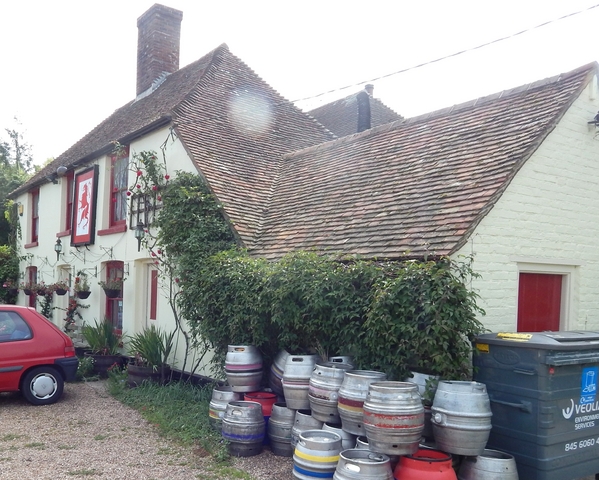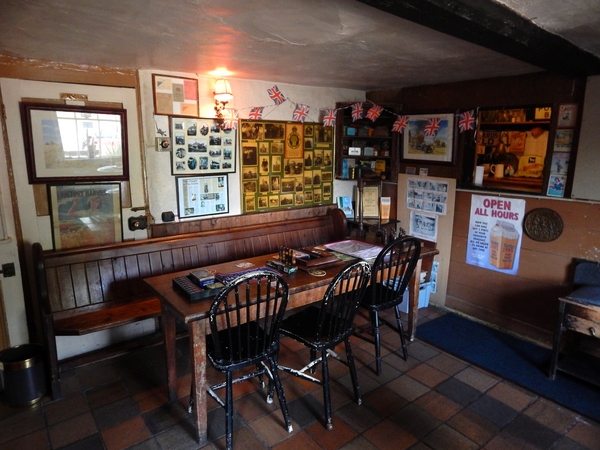The little pub that time forgot
Added: Wednesday, October 1st 2014

If you have trouble finding the Red Lion in Snargate, ask anyone for “Doris’s” and you’re home and dry. Doris Jemison has been running the pub for more than 50 years and can remember when a pint of bitter cost 10 pre-decimal pennies.
Doris is well into her 80s and her daughter Kate does most of the work in the small pub that dates from the early 16th century and, apart from the occasional lick of paint, hasn’t been decorated since 1890. But Doris is there every day, sitting quietly in a corner but happy to reminisce about her long life in the Red Lion.
Snargate is a tiny village in Kent with a population of 112. It’s so quiet you can hear not just birds singing but bees buzzing. Despite its small size, the village was home to a celebrity, the Impressionist painter Harold Gilman, who was brought up in the rectory alongside the church and became a member of the influential Camden Town group of artists in the early 20th century.
But there’s no doubt that it’s the Red Lion and Doris Jemison who are the celebrities today. The pub has been run by the Jemison family for more than 100 years and, with Kate in charge, the family control seems destined to continue for some time yet.
The Red Lion is a vivid, historic example of the way pubs have developed over the centuries. Back in the 16th century, they were no more than extensions of people’s homes and this is captured by the homely bar, a small lounge beyond it and a third room to the side that features a variety of rare old pub games, including nine men’s morris, toad-in-the-hole and table skittles.
The white-faced pub with its tall and imposing chimney is Grade II-listed. It’s commemorated by CAMRA, the Campaign for Real Ale, which has placed it on its national inventory of pubs of historic importance and named it local Pub of the Year and South-east Pub of the Year.

Inside, the pub has beams holding up a sagging ceiling, a marble topped bar, farmhouse furniture and cream-painted walls. It’s decorated throughout with a vast collection of World War Two memorabilia, including posters warning that “walls have ears” and to watch out for German spies, calls to arms from Winston Churchill, and many artefacts marking the work of the Women’s Land Army. Doris herself helped Dig for Victory in the Land Army that helped feed the nation during the war, and she returned to the tranquillity of the Red Lion at the end of hostilities.
The war-time memorabilia is fitting for Snargate, despite its quiet location, is in an area that has long been close to war and the threat of war. The village lies on the edge of the remote region of Kent known as Romney Marsh. It’s a slightly eerie place, with wide horizons, sudden sea mists, vast shingle beaches and flat fields criss-crossed by dykes to prevent flooding.
Along the coast, at such small towns as Dymchurch, there are Martello Towers, built so locals could watch out and give warning of a possible invasion by Napoleon’s France. The main mode of travel is in keeping with the eccentric nature of the region. The Romney Hythe & Dymchurch railway is the world’s smallest commercial service, 13½ miles of track with trains one-third of normal size, tiny carriages drawn by steam locos on 15 inch-gauge lines. The line was requisitioned by the Ministry of War during WWII to carry munitions and when it reopened for passengers in 1947 a ribbon was ceremonially cut by Laurel and Hardy: I doubt Oliver Hardy could have squeezed in to one of the carriages.
Romney Marsh is rich in pubs, including the celebrated Mermaid in Rye, the Star Inn at St Mary in the Marsh and the Ship Inn in Dymchurch. Posters at Dymchurch station advertise not only the Ocean Inn but also Dr Syn’s Guest House, which sounds the ideal location for people enjoying illicit activities away from the matrimonial bed. But Dr Syn is a mythical Romney Marsh character, based on a series of novels featuring a local cleric who at night roamed the marshes dressed as a sepulchral skeleton, organising local smuggling gangs who brought in French brandy and cigars under noses of the excise officers.

Back at the Red Lion, Doris’s daughter Kate was looking after two regulars (pictured below) and said: “It’s quiet today but it can get lively.” The pub draws people like a magnet from far and wide and stages regular beer festivals. The beer comes from handpumps and by gravity from casks. The pub has long been a supporter of Goacher’s Brewery in Maidstone, one of the country’s earliest micros, which – fittingly for the Red Lion – still brews mild as well as bitter. Beers from other Kent breweries, including Whitstable, are on offer.
The Red Lion is, simply, one of the finest pubs you’ll ever see. Do visit and find time for a chat with the wonderful Doris. But remember to re-set your watches to the 1950s.
*Print version: Publican’s Morning Advertiser, 1 October 2014.







